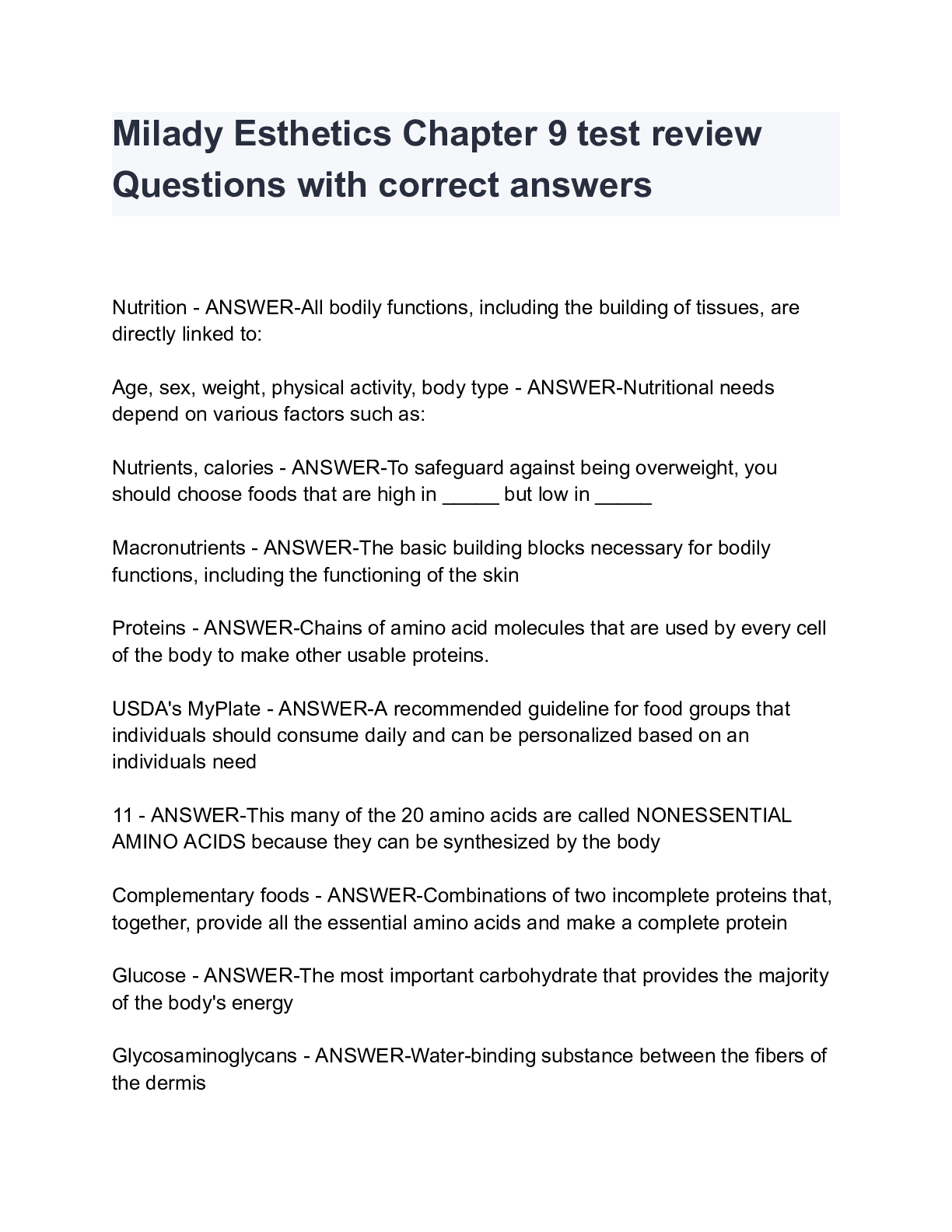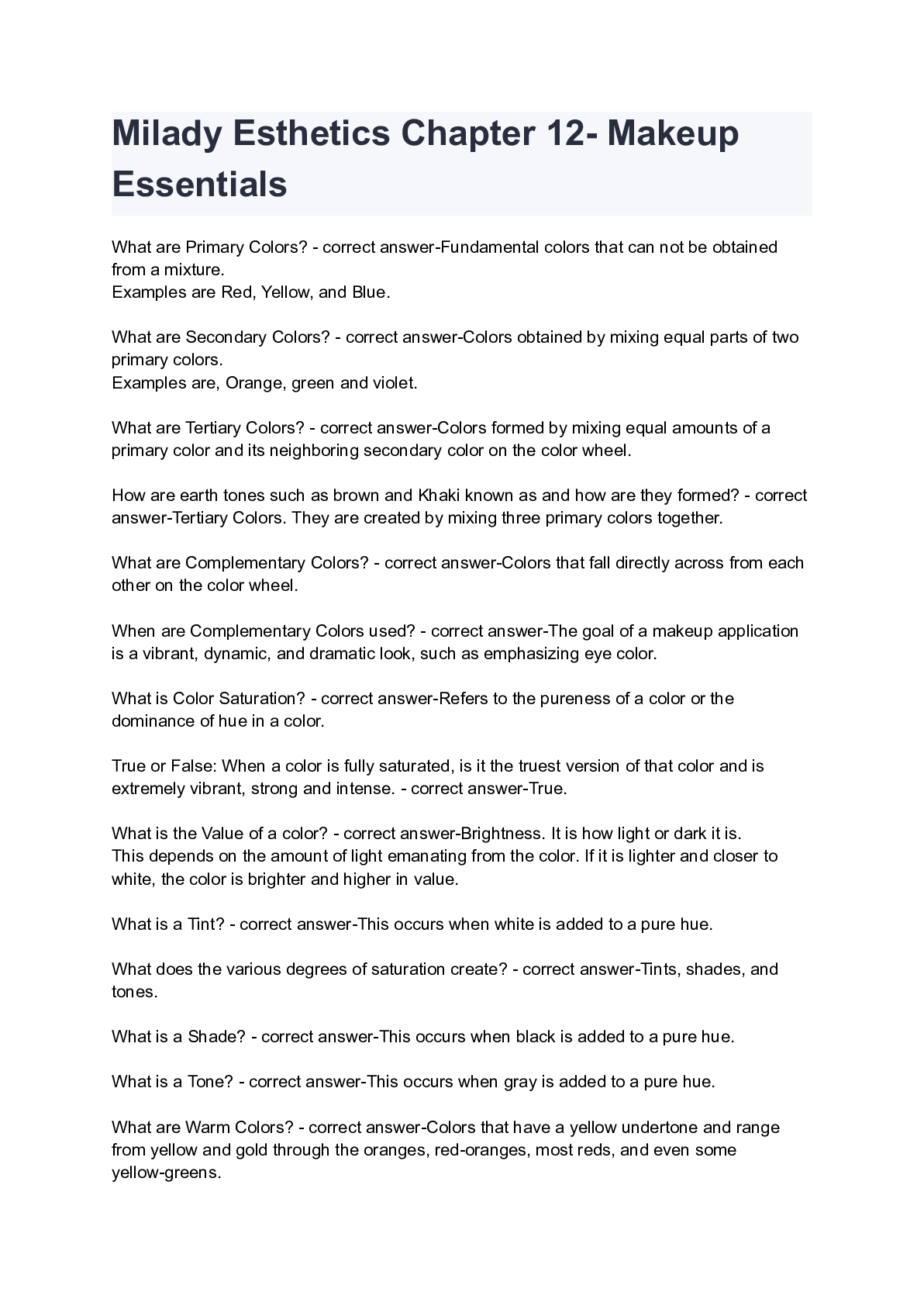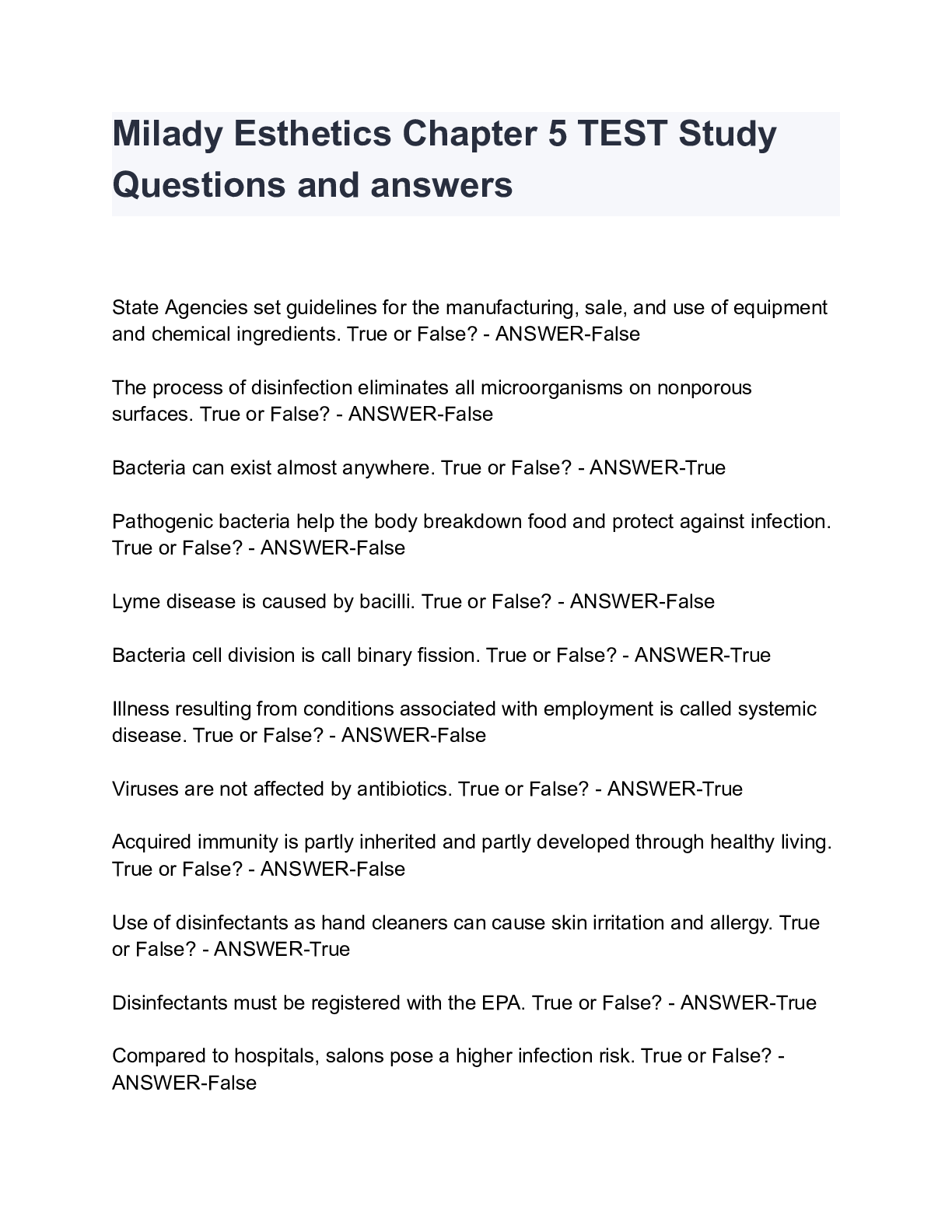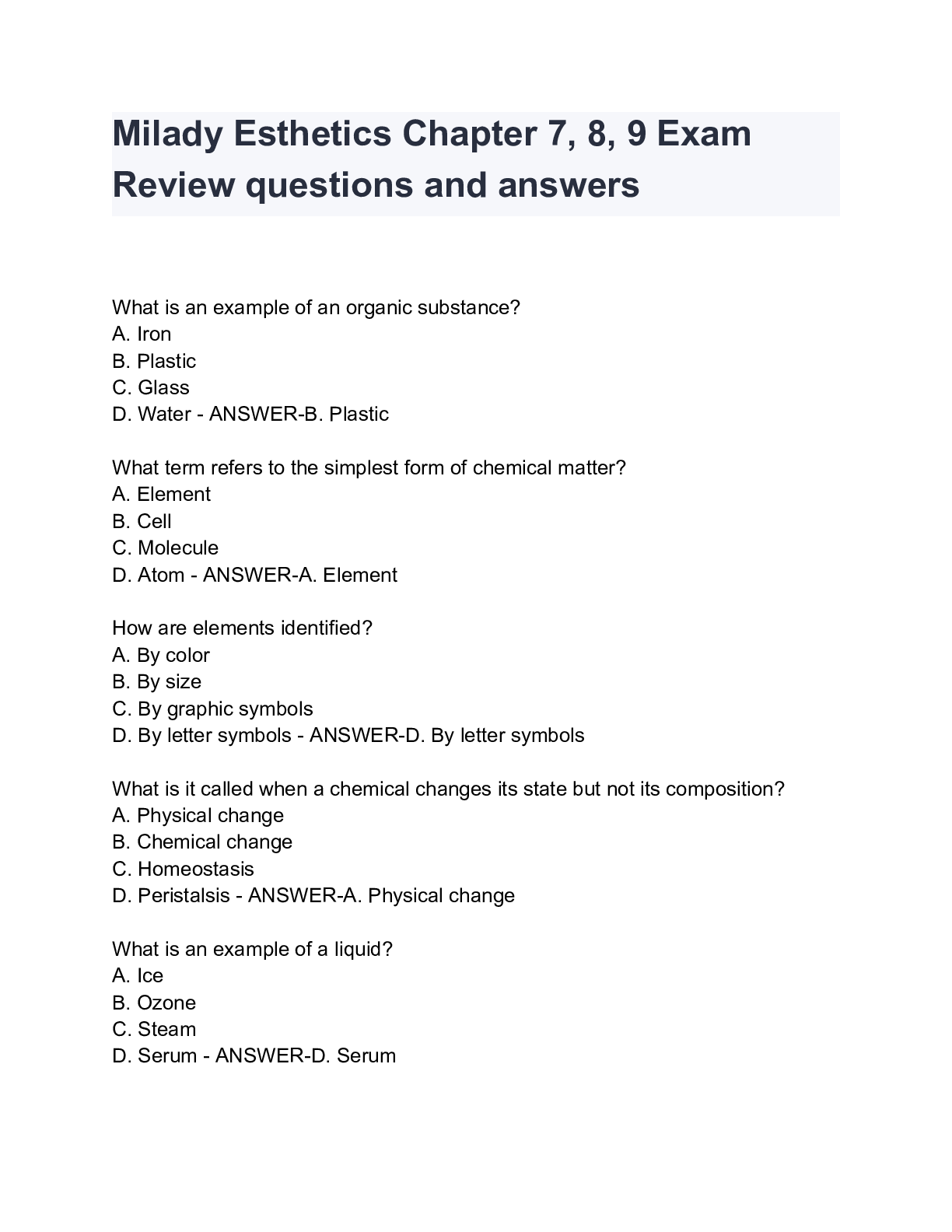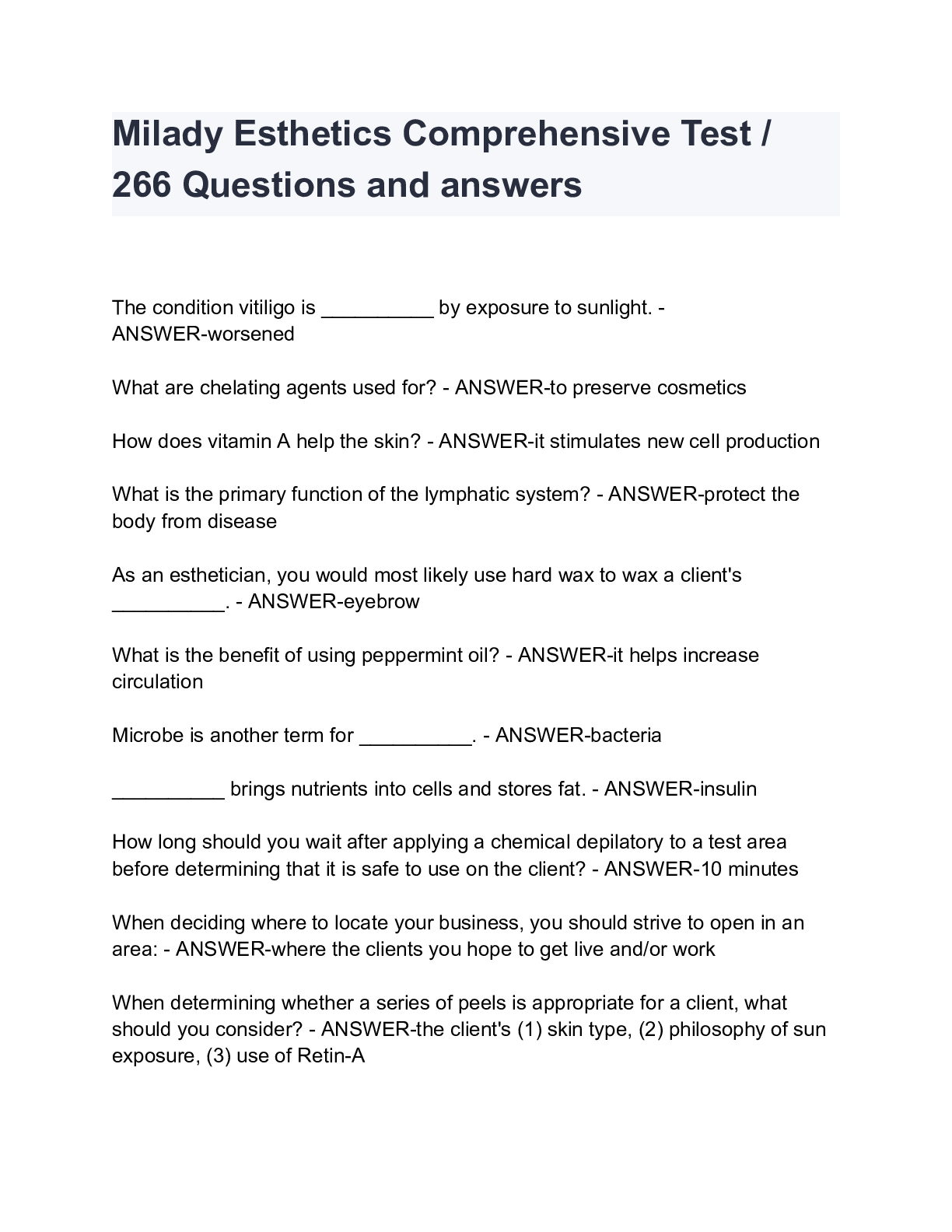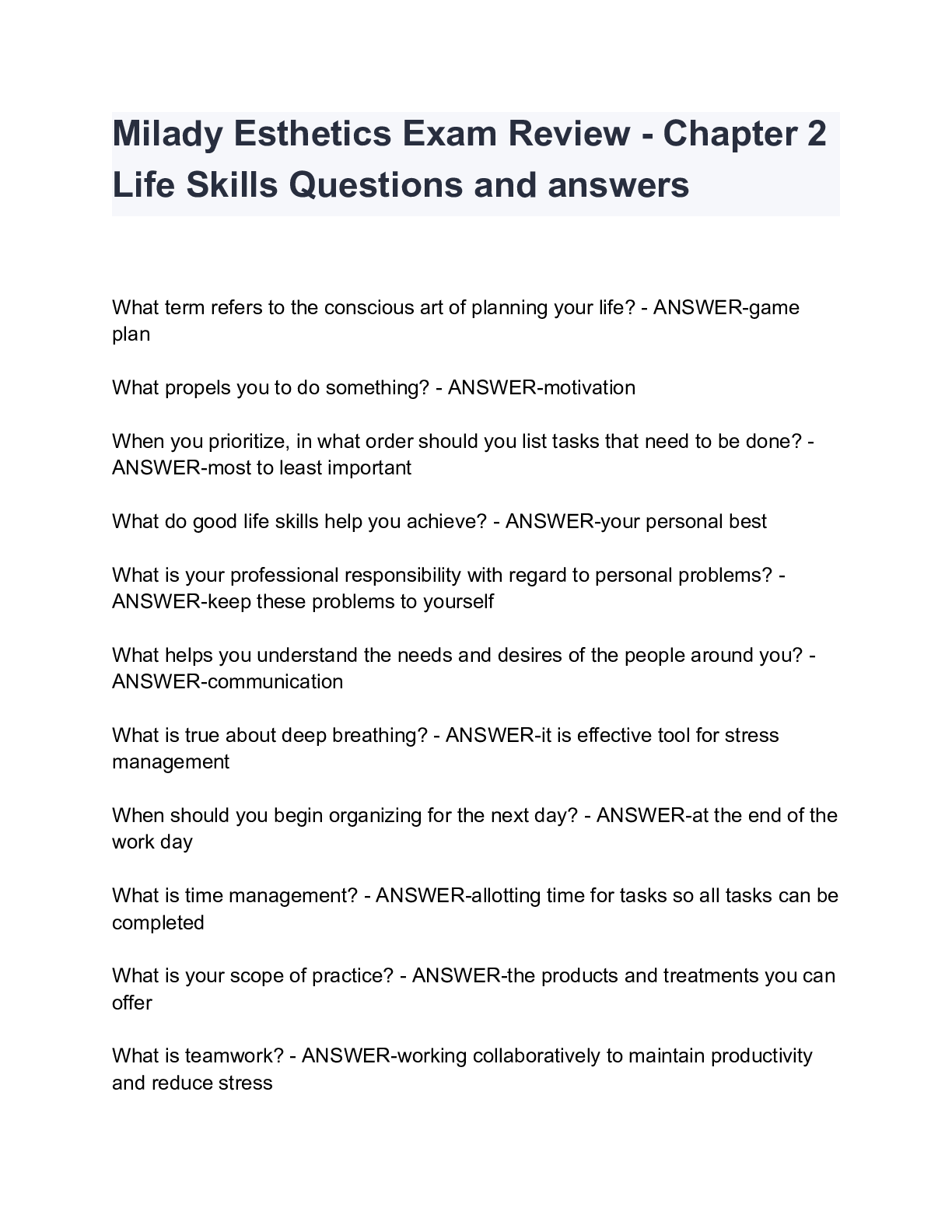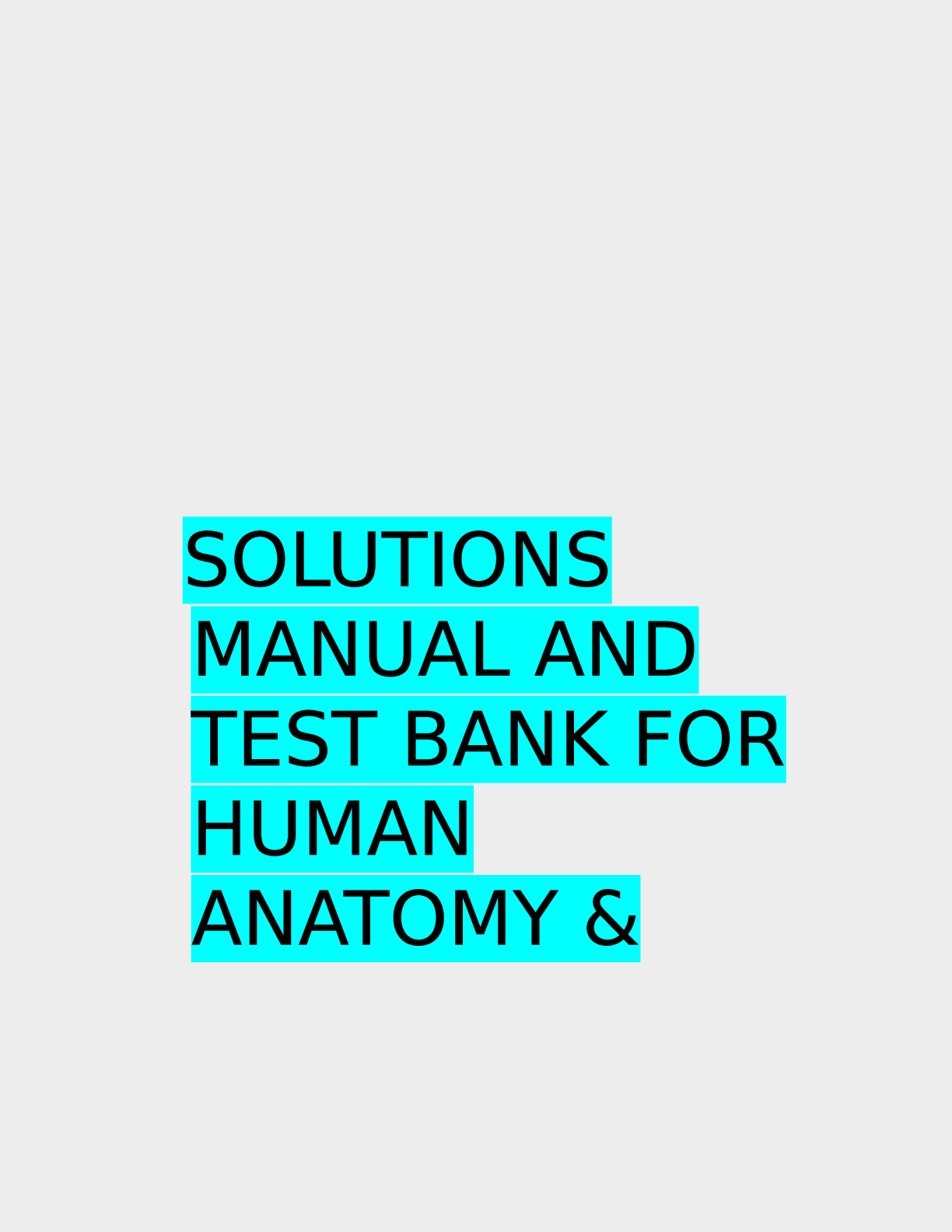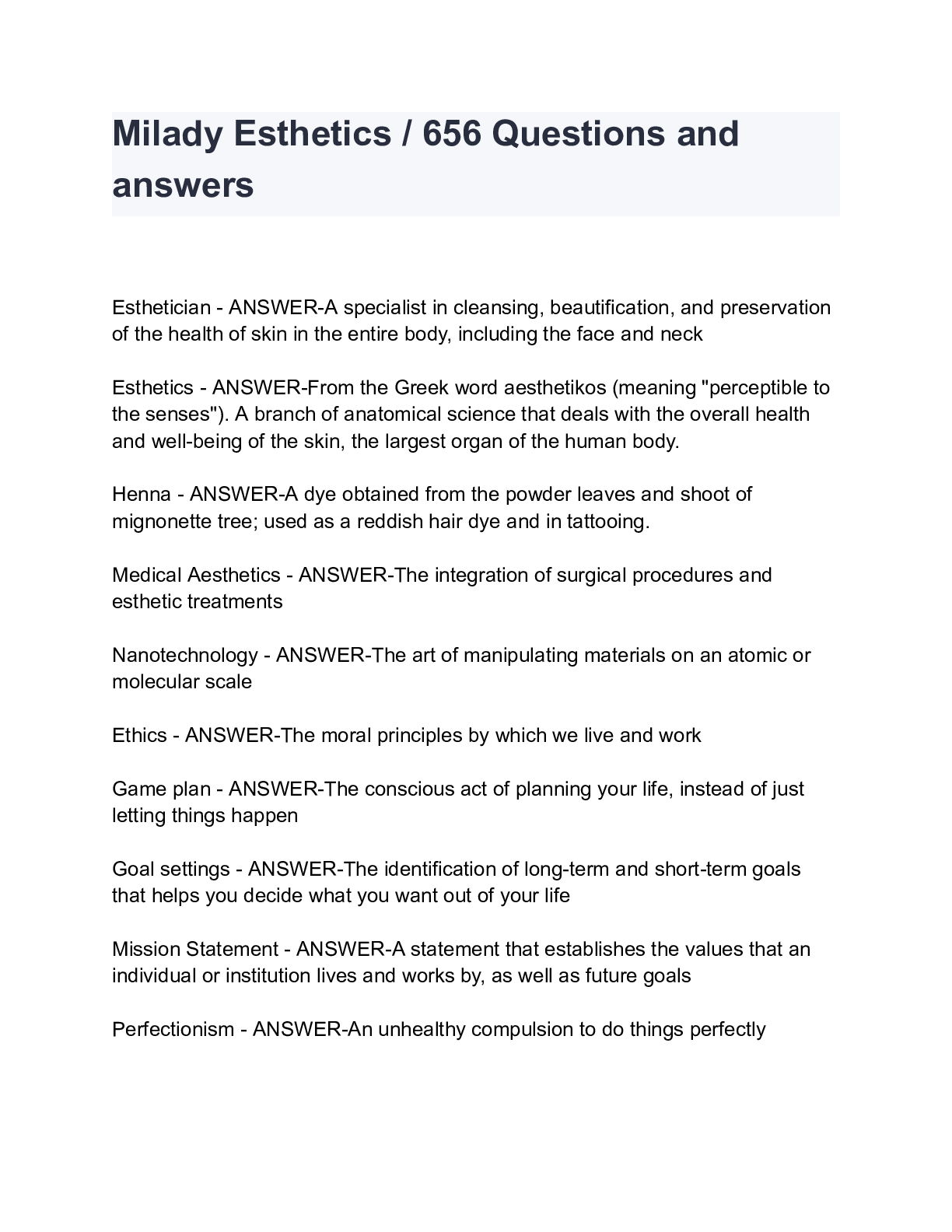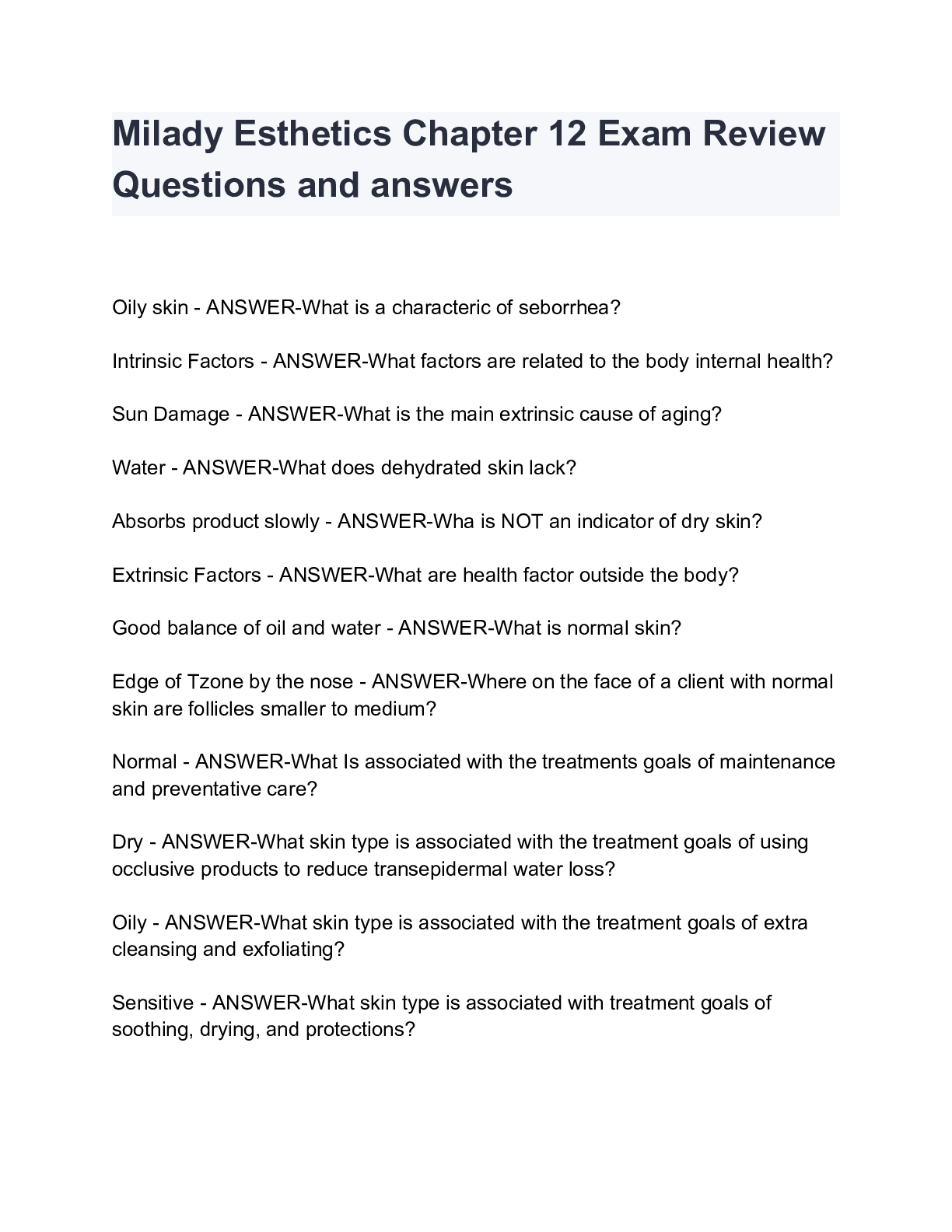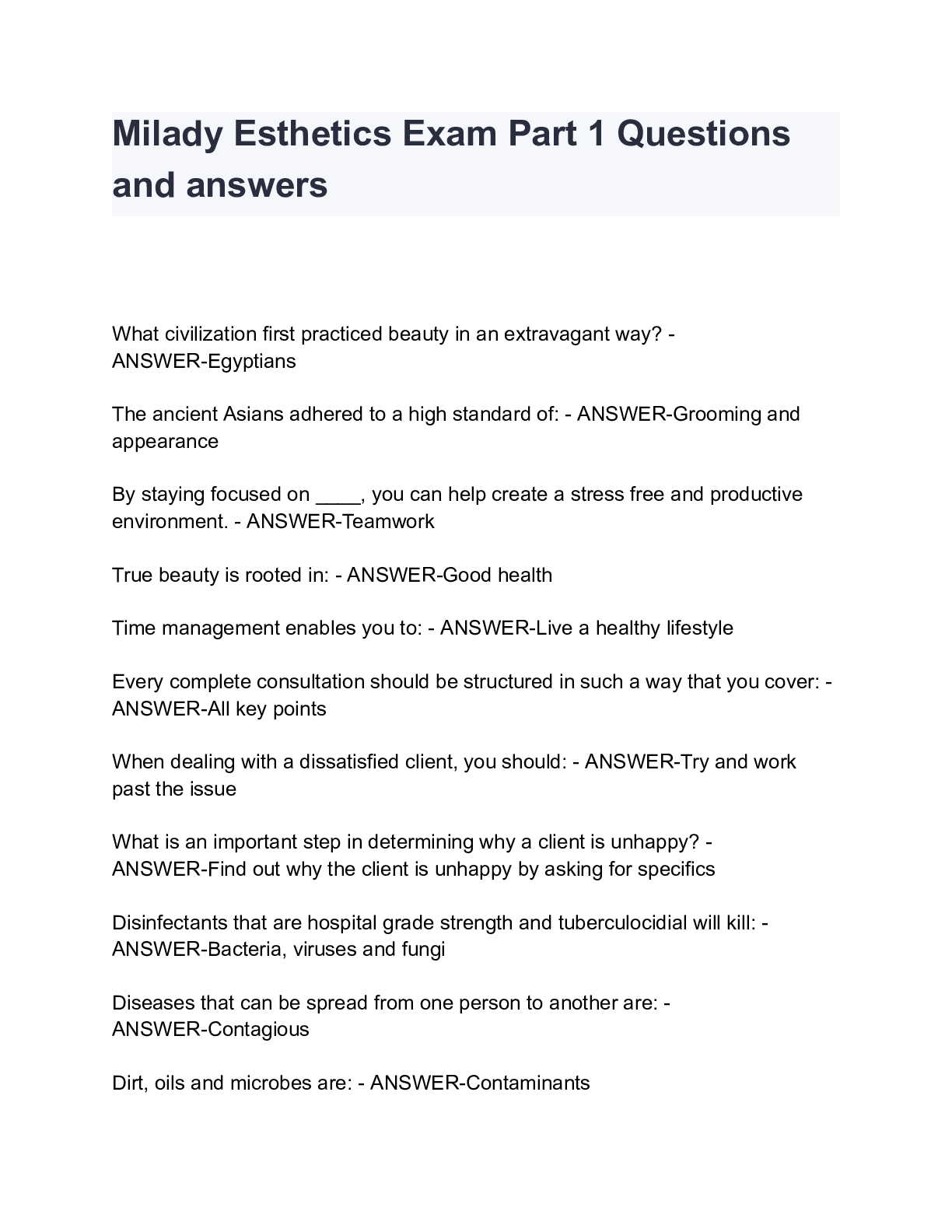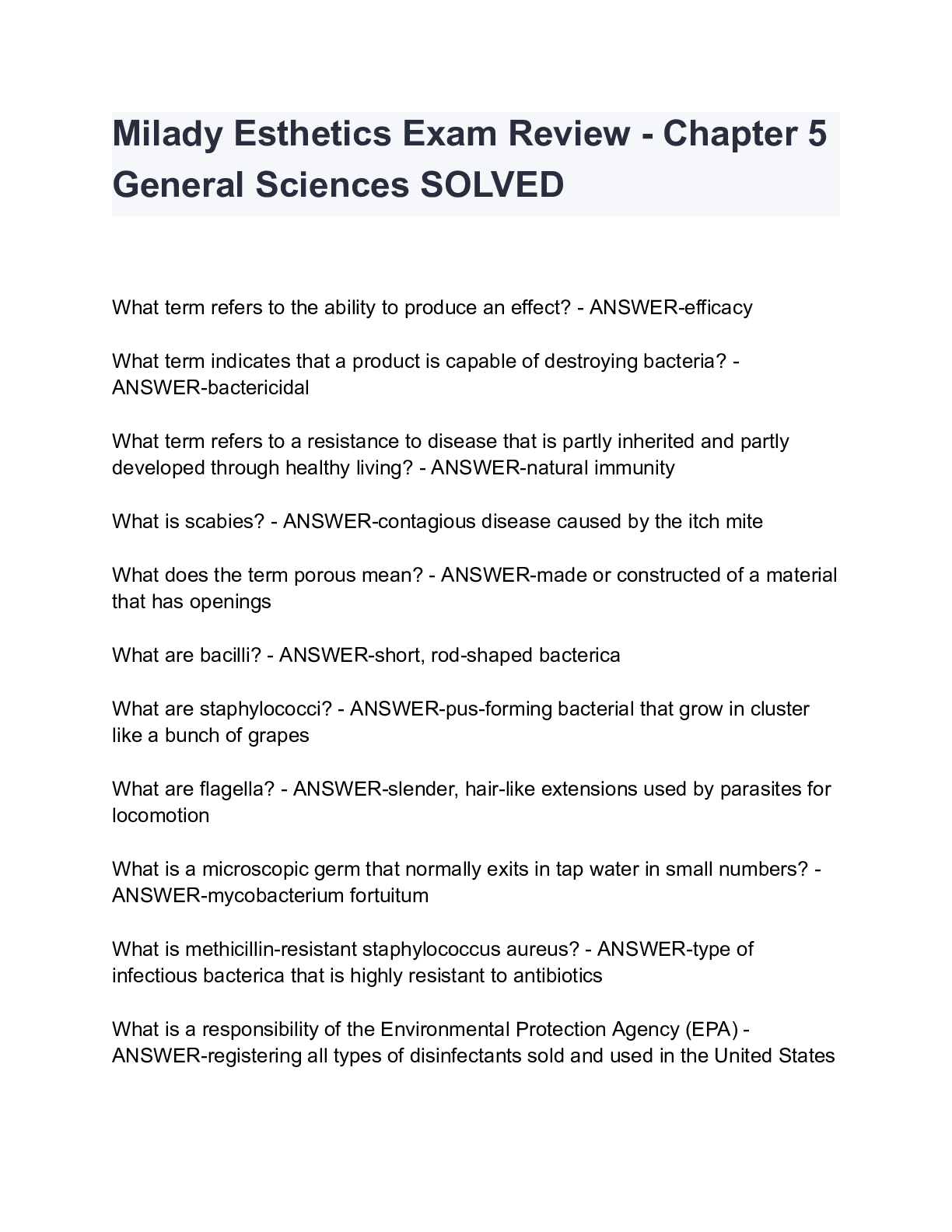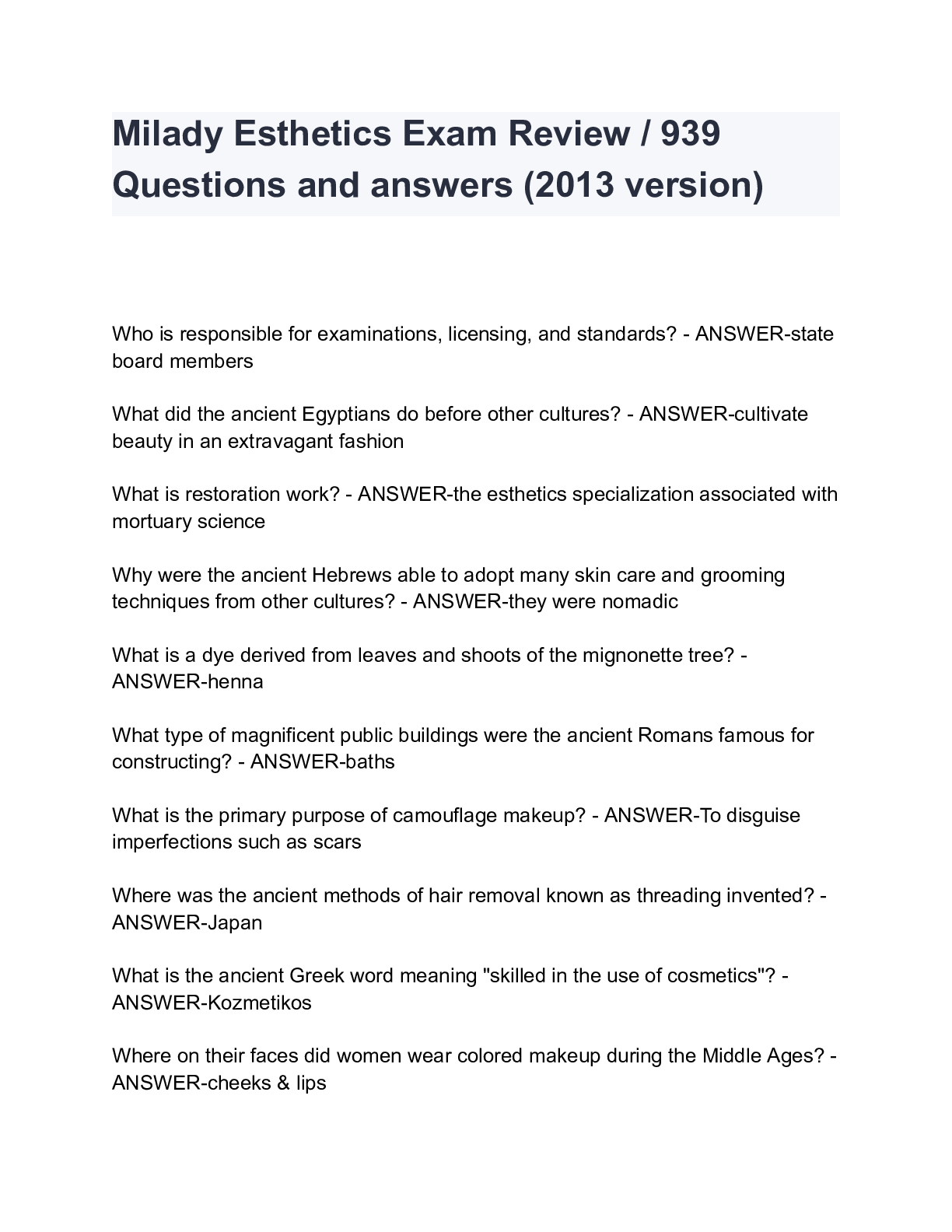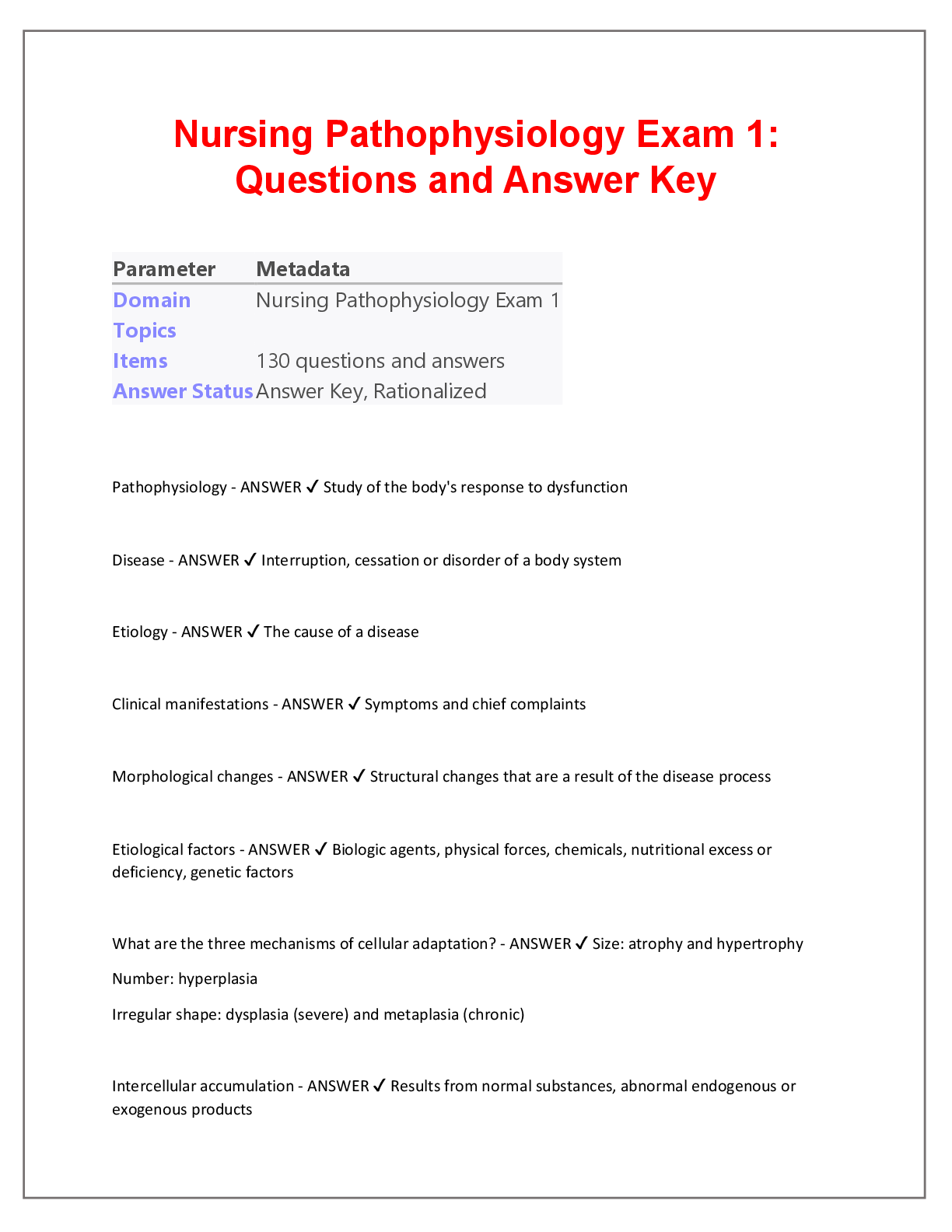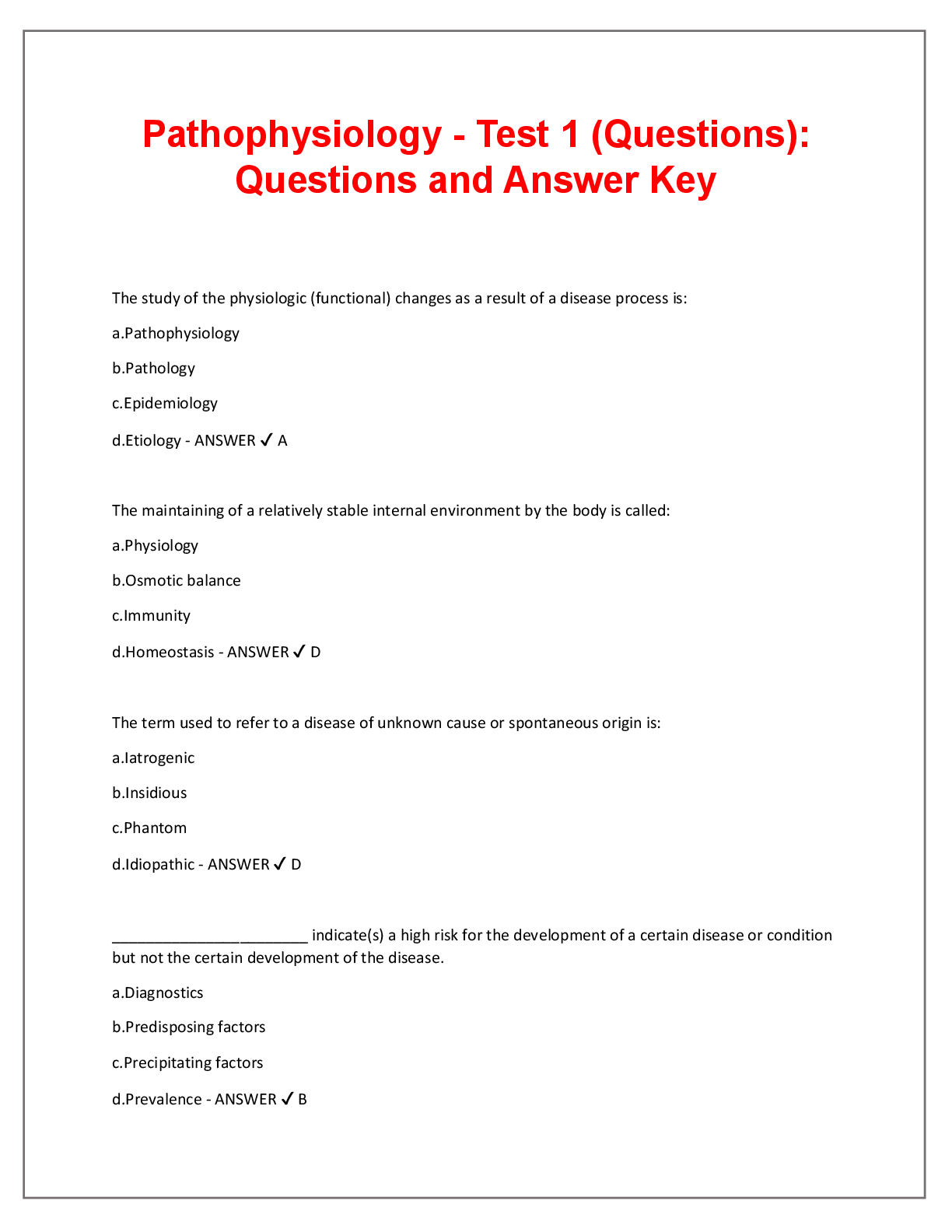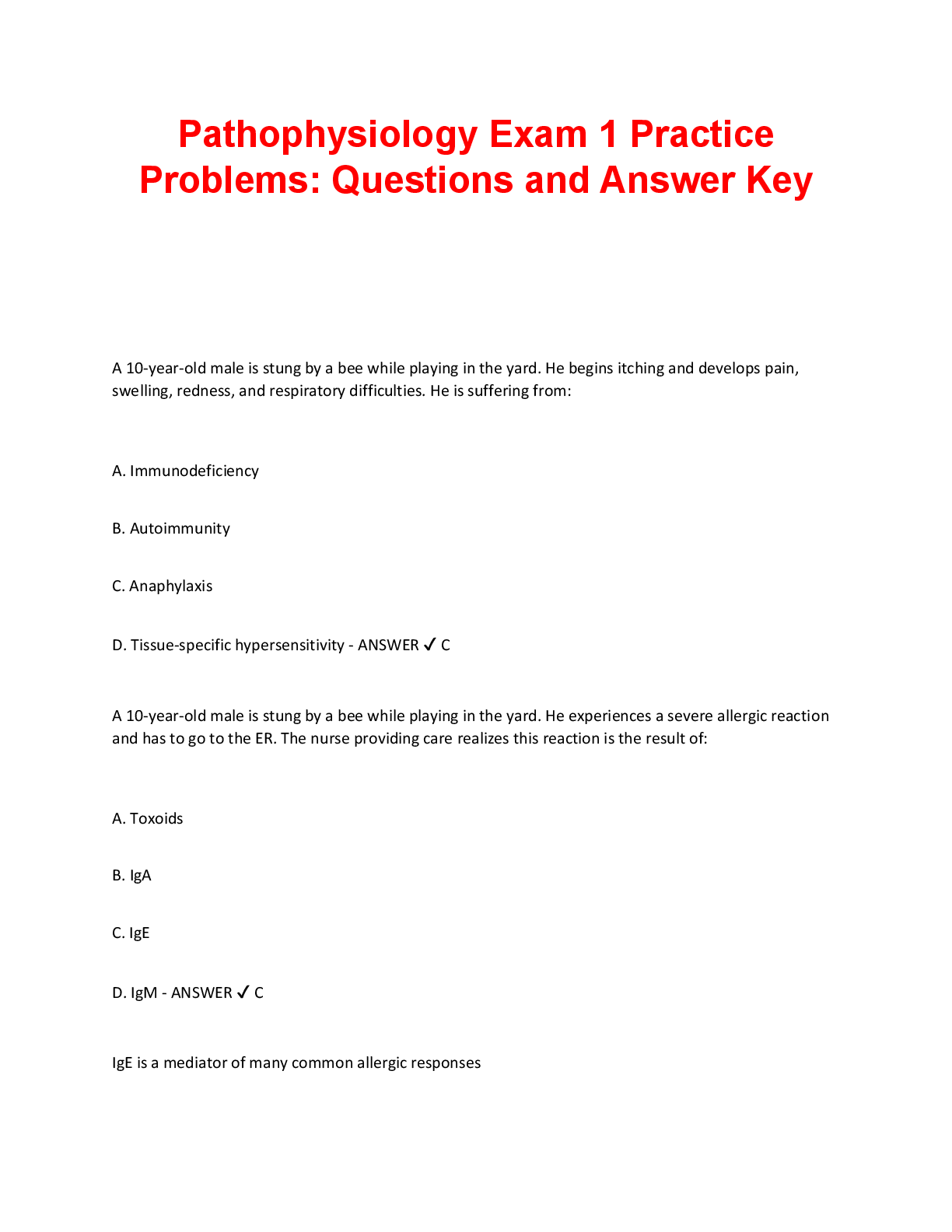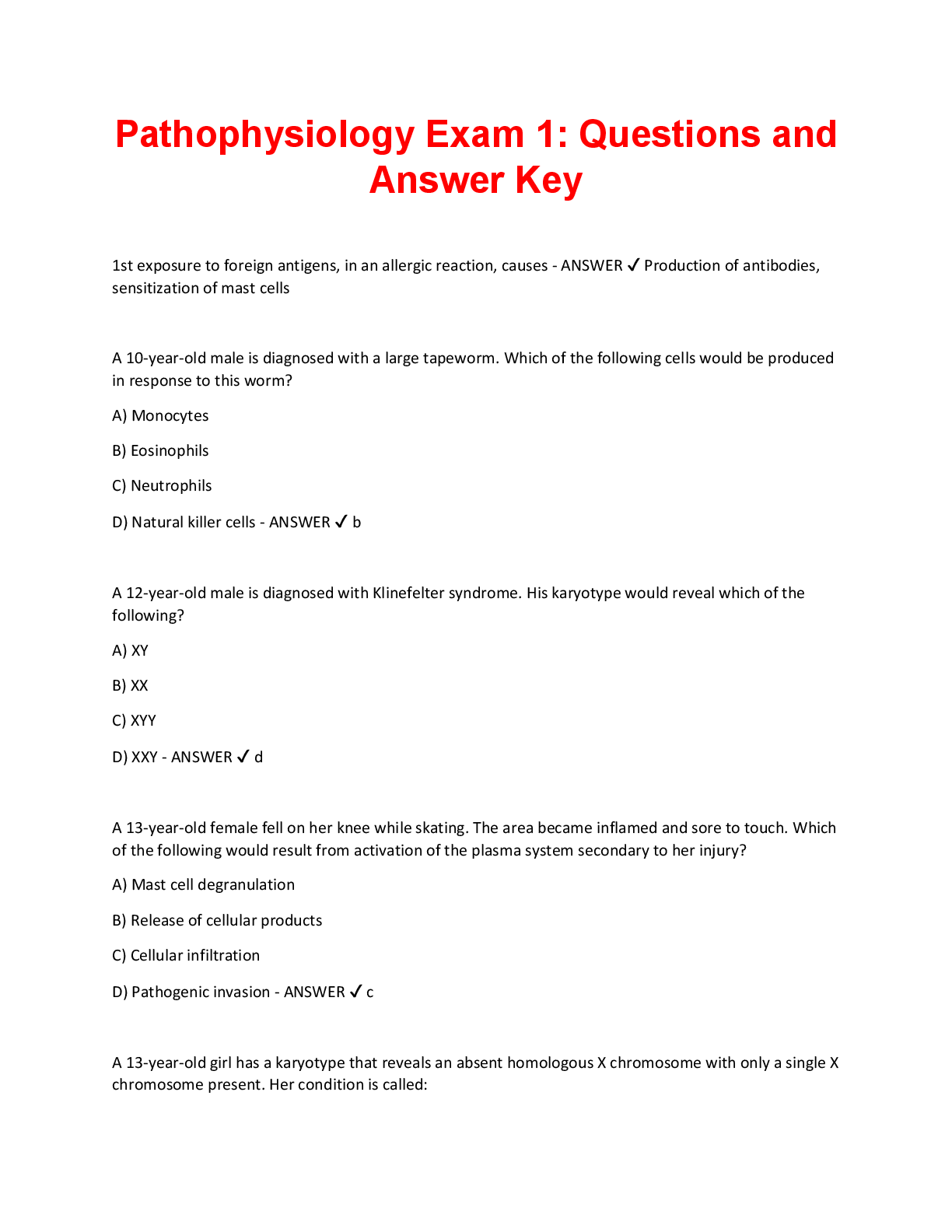Pathophysiology > QUESTIONS and ANSWERS > Pathophysiology Exam 1 Rasmussen: Questions and Answer Key (All)
Pathophysiology Exam 1 Rasmussen: Questions and Answer Key
Document Content and Description Below
3 stages of adaptation (GAS) - ANSWER ✔ alarm reaction, stage of resistance, stage of exhaustion 4 topics of pathophysiology - ANSWER ✔ etiology, pathogenesis, clinical manifestations, treatment ... 5 cardinal signs of inflammation - ANSWER ✔ heat, redness, swelling, pain, loss of function 7 warning signs of cancer - ANSWER ✔ (CAUTION) Change in bowel or bladder habits A sore that does not heal Unusual bleeding or discharge Thickening or lump in breast or elsewhere Indigestion or difficulty swallowing Obvious change in wart or mole Nagging cough or hoarseness active immunity - ANSWER ✔ A form of acquired immunity in which the body produces its own antibodies against disease-causing antigens. active transport - ANSWER ✔ requires energy, against the gradient from low concentration to high (ex: endocytosis (entering cell), exocytosis(exiting cell), and protein pumps) acute - ANSWER ✔ sudden onset and short duration adaptation/resistance stage - ANSWER ✔ trying to return to homeotasis alarm stage - ANSWER ✔ fight or flight response reduced resistance to stressors release catecholamines (epinephrine and norepinephrine) and adrenocortical steroids (cortisol and aldostrone) antimicrobial resistance - ANSWER ✔ occurs when pathogens undergo changes that allow them to resist antimicrobials (Ex: MRSA) atopic dermatitis - ANSWER ✔ Excess inflammation; dry skin, redness, and itching from allergies and irritants. (eczema) Bicarbonate value normal range (second most abundant anion in blood) - ANSWER ✔ 23-30 mEq/L Calcium value normal range - ANSWER ✔ 9-11 mg/dL OR 4.5-5.5 mEq/L causes of edema - ANSWER ✔ increased capillary hydrostatic pressure, loss of plasma proteins, obstruction of lymphatic circulation, increased capillary permeability Causes of extracellular fluid deficits - ANSWER ✔ loss of total body sodium-Vomiting, diarrhea, excessive sweating, burns, diuretics or kidney failure. chronic - ANSWER ✔ long term clinical manifestation - ANSWER ✔ signs and symptoms or evidence of disease Components of the Immune System - ANSWER ✔ (1) skin and mucous membranes; (2) the mononuclear phagocyte system; (3) the lymphoid system, including spleen, thymus gland, and lymph nodes; and (4) bone marrow. AND B cells; T cells condition of high calcium > 11mg/dL - ANSWER ✔ hypercalcemia Condition of high chloride > 106 mEq/L - ANSWER ✔ Hyperchloremia Condition of high magnesium >2.5 mEq/L - ANSWER ✔ Hypermagesemia Condition of high phosphate > 4.5 mg/dL - ANSWER ✔ Hyperphosphatemia Condition of high potassium >5 mEq/L - ANSWER ✔ Hyperkalemia Condition of high sodium>145 mEq/L - ANSWER ✔ hypernatremia condition of low calcium< 9mg/dL - ANSWER ✔ hypocalcemia Condition of low chloride <96 mEq/L - ANSWER ✔ hypochloremia Condition of low magnesium <1.5 mEq/L - ANSWER ✔ hypomagnesemia condition of low phosphate < 2.5 mg/dL - ANSWER ✔ hypophophatemia Condition of low potassium < 3.5 mEq/L - ANSWER ✔ hypokalemia Condition of sodium < 135 mEq/L - ANSWER ✔ hyponatremia / hypernatremia Define cachexia - ANSWER ✔ weakness and wasting of the body due to severe chronic illness Define endotoxins - ANSWER ✔ Stays INSIDE the cell. can lead to septic define exotoxins - ANSWER ✔ those toxins which are secreted in the area surrounding a cell Define Leukopenia - ANSWER ✔ decrease in WBC Define metastasis - ANSWER ✔ The spread of cancer cells beyond their original site Define thrombocytopenia - ANSWER ✔ low platelet count Dehydration (etiology, clinical manifestations, and treatment) - ANSWER ✔ Causes: vomiting, diarrhea, removal of saline from the body causes extracellular volume deficit and removal of extra water from the body causes hypernatremia, the combination is dehydration. S/S: hard stools, sudden weight loss, rapid pulse, oliguria, prolonged capillary refill time, decreased skin turgor, dry mouth, absence of sweat and tears, confusion, lethargy, thirst Treatment: replenish fluids PO or IV Difference between osmosis and diffusion - ANSWER ✔ osmosis is the diffusion of water and diffusion is the movement of any type of molecule across the cell membrane from a high to low concentration. Etiology - ANSWER ✔ The study of the causes and origins of disease exacerbation - ANSWER ✔ a relatively sudden increase in the severity of a disease or any of its signs and symptom example of hypersensitivity type 1 - ANSWER ✔ allergic reaction example of hypersensitivity type 2 - ANSWER ✔ transfusion reactions and hemolytic disease of a newborn Example of hypersensitivity type 3 - ANSWER ✔ immune complex reactions Example of primary prevention - ANSWER ✔ Immunization, health/sex ed, quit smoking drinking or poor diet. Examples of active immunity - ANSWER ✔ natural infection, vaccines, toxoid Examples of passive immunity - ANSWER ✔ IgA in breast milk, maternal IgG crossing placenta, antitoxin, serotherapy (direct injection of antibodies) examples of secondary prevention - ANSWER ✔ Self breast exams, yearly cancer screenings, proper management of diabetes Examples of tertiary prevention - ANSWER ✔ rehabilitation after brain injury, surgery to correct chronic or recurring illness, medication to prevent chronic symptoms exhaustion stage - ANSWER ✔ cannot return to homeostasis, energy sources depleted, disease process sets in and permanent symptoms show up. Fibromyalgia - ANSWER ✔ chronic condition with widespread aching and pain in the muscles and fibrous soft tissue function of mitochondria - ANSWER ✔ Cellular respiration, makes ATP. Gout - ANSWER ✔ hereditary metabolic disease that is a form of acute arthritis, characterized by excessive uric acid in the blood and around the joints Herpes - ANSWER ✔ A viral infection causing small painful blisters and inflammation, most commonly at the junction of skin and mucous membrane in the mouth or nose or in the genitals (1 above waist, 2 below) Goes dormant and can come back as shingles. Hormones released during GAS - ANSWER ✔ catecholamines (epi and norepi) adrenocortical steroids (cortisol and aldosterone) endorphines and enkephalins (endogenous opiods, increase pain threshold, produce sedation and euphoria) Immune cytokines (enhance immune system, when prolonged they suppress it) Sex hormones (estrogen and testosterone) Growth hormone Oxytocin (female "tend+befriend" vs fight or flight) Hypercalcemia causes and treatment - ANSWER ✔ Causes: hyperparathyroidism, malignant tumors, kidney failure, excessive calcium or vitamin d supplements, prolonged immobility Treatment: Cardiac monitoring, interventions depend on cause but drug therapy can be used to reduce levels. If caused by diuretics, dosage changed/discontinued Hypercalcemia S/S - ANSWER ✔ Muscle weakness, Constipation, Anorexia, N/V, Polyuria, confusion, increased HR and BP, Dysrhythmias, blood clots form easily, risk for DVT Hyperkalemia causes and treatment - ANSWER ✔ Causes: ACE inhibitors, kidney failure, multiple blood transfusions, excessive or too rapid IV potassium Treatment: Excrete excess potassium (with drugs), force potassium from ECF back into cells Hyperkalemia S/S - ANSWER ✔ Mild cramping, hyperactive bowel sounds, diarrhea, muscle weakness starting in lower extremities and ascends, Bradycardia, Dysrhythmias, Tall T waves on ECG, Cardiac arrest Hypermagnesemia causes and treatment - ANSWER ✔ Causes: Kidney disease, overuse of magnesiumcontaining antacids or laxatives, excessive mag intake, IV mag replacement therapy Treatment: If caused by excessive intake, decrease it, if due to kidney failure dialysis is used, if no kidney failure, give IV fluids to dilute, or loop diuretics to help excretion. Hypermagnesemia S/S - ANSWER ✔ Brady, hypotension, cardiac arrest, lethargy, coma, resp failure, death Hypernatremia causes and treatment - ANSWER ✔ Causes: Kidney failure, long term corticosteroid use, excessive sodium intake (diet or IV), watery diarrhea, dehydration Treatment: Hemodialysis for kidney failure, fluid replacement for water loss, diuretics to help rid body of excess fluid and sodium Hypernatremia S/S - ANSWER ✔ S = Skin flushed A = Agitation L = Low-grade fever T = Thirst eye twitching Hyperphosphatemia causes and treatment - ANSWER ✔ Causes: increased phosphate intake, shift from cells to EFC, decreased phosphate excretion Treatment: Hyperphosphatemia S/S - ANSWER ✔ Causes hypocalcemia: +Trousseau's and Chvosteks Hypersensitivity - ANSWER ✔ an exaggerated response by the immune system to a particular substance Hypocalcemia causes and treatment - ANSWER ✔ Causes: Hypoparathyroidism, vitamin D deficiency, malabsorption (from Crohn's or Celiac) immobility, diarrhea, inadequate oral calcium intake Treatment: focus on replacing calcium and/or vitamin D, until corrected keep patients on seizure precautions, in a low stimulus environment Hypocalcemia S/S - ANSWER ✔ Diarrhea, Numbness, Tingling of extremities and around mouth, Convulsions, Positive Chvostek sign, Positive Trousseau sign, painful cramps ('charlie horses') Brady, brittle bones, Hypokalemia causes and treatment - ANSWER ✔ Causes: Diuretic use, N/V, NPO too long, unbalanced diet, corticosteroids, prolonged ng suctioning, water intoxication Treatment: Replace potassium either IV or PO Hypokalemia S/S - ANSWER ✔ altered muscle function and weakness,Abd distention, bloating, diminished bowels sounds, constipation, Dysrhythmias, Flat T waves on ECG, hyper polarization leads to less reactive to stimuli, postural hypo tension Hypomagnesemia causes and treatment - ANSWER ✔ Causes: Diuretic use, inadequate intake, chronic alcoholism, diarrhea, celiac, crohns, chemo, anti-rejection drugs, mass transfusion Treatment: replacement with mag sulfate, monitor closely to prevent hypermag Hypomagnesemia S/S - ANSWER ✔ Torsades de Pointes (tornado in the heart) Afib, Vfib, Prolonged QT, flattened T wave, N/T, painful muscle contractions, decreased GI, constipations, nausea, paralytic ileus Hyponatremia causes and treatment - ANSWER ✔ causes: Diuretic use, excessive sweating, NPO for too long, excessive consumption of water/beer/other hypertonic fluids Treatment: if caused by diuretics, doses of those drugs will need to be changes or discontinued Hyponatremia S/S - ANSWER ✔ hyperactive bowel sounds, Weakness, Lethargy, Confusion, Muscle cramps, Twitching, Seizures, Coma, Death Hypophosphatemia causes and treatment - ANSWER ✔ Causes: decreased phosphate intake, shift from ECF to cells, increased phosphate excretion. Treatment: Hypophosphatemia S/S - ANSWER ✔ ↓Cardiac Output and Contractility Slowed Respirations Weakness ↓DTR ↓Bone Density Irritability/Confusion/Seizures ↓Platelet aggregation ↑Bleeding Immunosupression identify antibody IgA - ANSWER ✔ is two antibodies together to create a dimer produced by plasme cells located in tissue under skin/mucous membranes primarily in saliva, tears, tracheobrachial secretions, colostrum, breast milk, and GI/GU secretion identify antibody IgD - ANSWER ✔ found in tiny amounts in serum located primarily on B cell membranes Thought to be cellular antigen receptor that acts to stimulate B cell to multiply, differentiate, secrete other specificc immunoglobins Identify antibody IgE - ANSWER ✔ circulates as a single molecule bound by Fc tail to receptors on basophil and mast cell surfaces helps in immunity against helminthic parasites responsible for initiating inflammatory and allergic reactions functions as signaling molecule causes mast cell degranulationwhen antigen detected at mast cell surface. Identify Antibody IgG - ANSWER ✔ most common Protects the body from infection smallest easily escapes the bloodstream circulates as single molecules Identify antibody IgM - ANSWER ✔ first to be produced when exposed to antigen/immunization consists of five antibody molecules joing together to form a pentamer major antibody found on B-cell surfaces. works best as active component inflammatory markers of infections - ANSWER ✔ High ESR, High WBC, HIgh CRP Magnesium value normal range - ANSWER ✔ 1.5-2.5 mEq/L mediators of acute inflammation - ANSWER ✔ histamine, serotonin, bradykinin, prostaglandins, leukotrienes muscular dystrophy - ANSWER ✔ group of hereditary diseases characterized by degeneration of muscle and weakness myasthenia gravis - ANSWER ✔ a chronic AUTOIMMUNE disease that affects the neuromuscular junction and produces serious weakness of voluntary muscles osmosis - ANSWER ✔ passive transport of water, moving from high to low Osteoarthritis - ANSWER ✔ a degenerative joint disease in which the cartilage covering the surface of bone becomes thinner and rougher (noninflammatory) osteocarcoma - ANSWER ✔ a malignant tumor of the bone and is most common in the mandible. Osteoporosis - ANSWER ✔ A condition in which the body's bones become weak and break easily. passive immunity - ANSWER ✔ Transfer of performed antibodies against a specific antigen from protected or immunized individual to an unprotected or non-immunized individual passive transport - ANSWER ✔ requires no energy, along the gradient from high concentration to low (ex: diffusion, osmosis, facilitated diffusion) pathogenesis - ANSWER ✔ development or evolution of a disease Pathology - ANSWER ✔ the study and diagnosis of disease through examination of organs, tissues, cells, and bodily fluids Pathophysiology - ANSWER ✔ the study of abnormalities in physiologic functioning of living beings [Show More]
Last updated: 1 month ago
Preview 5 out of 32 pages

Loading document previews ...
Buy this document to get the full access instantly
Instant Download Access after purchase
Buy NowInstant download
We Accept:

Reviews( 0 )
$11.00
Can't find what you want? Try our AI powered Search
Document information
Connected school, study & course
About the document
Uploaded On
Jun 07, 2025
Number of pages
32
Written in
Additional information
This document has been written for:
Uploaded
Jun 07, 2025
Downloads
0
Views
10

